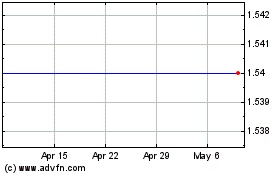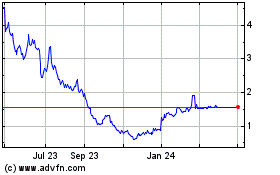NGM Bio Presents Phase 1 Safety and Pharmacokinetics Data for NGM621, an Anti-Complement C3 Antibody, in Patients with Geogra...
November 13 2020 - 8:00AM

NGM Biopharmaceuticals, Inc. (Nasdaq: NGM), a biotechnology company
focused on discovering and developing transformative therapeutics
for patients, announced that findings from its Phase 1 clinical
study of NGM621, an anti-complement C3 antibody, in patients with
geographic atrophy (GA) were presented today at the American
Academy of Ophthalmology 2020 Virtual. The poster presentation
titled, “Inhibition of Complement Component 3 in GA With NGM621:
Phase 1 Dose-Escalation Study Results,” was given by the study’s
lead investigator Charles C. Wykoff, M.D., Ph.D., Director of
Research at Retina Consultants Houston and the Greater Houston
Retina Research Foundation. The presentation is available on the
NGM Bio website here.
The primary objective of the Phase 1 trial was to assess the
safety and tolerability of single and multiple intravitreal (IVT)
injections of NGM621 in patients with GA. Secondary objectives were
to characterize the serum PK of single or multiple doses of NGM621.
The study enrolled 15 patients across three single-ascending dose
cohorts of NGM621, 2 mg, 7.5 mg and 15 mg, the maximum planned dose
in the study, and a multiple dose cohort that received two 15 mg
doses separated by four weeks. Patients were dosed sequentially and
followed closely over 12 weeks.
In the study, NGM621 was well tolerated, with no patients
experiencing serious adverse events (SAEs), drug-related adverse
events (AEs), intraocular inflammation, endophthalmitis or
choroidal neovascularization (CNV). No dose-related safety patterns
or concerns were reported. Ocular AEs observed were mild in
severity and representative of those commonly associated with IVT
injections. No vision-related safety signals were detected. On
average, patients maintained their visual acuity over the 12-week
follow-up study duration.
The serum PK of NGM621 was linear and dose-proportional. Based
on ocular PK/PD modeling, NGM621 is predicted to achieve >90%
reduction in free C3 in the eye for 7 weeks following a single IVT
dose of 15 mg. Taken together, the PK profile of NGM621
demonstrated in the Phase 1 study and subsequent PK/PD modeling
support up to an every eight-week (or every other month) dosing
regimen of NGM621 at the 15 mg dose level. NGM621 serum exposure
was below concentrations expected to produce systemic complement
inhibition after IVT injection of the 15 mg dose. No anti-drug
antibodies were detected in any patient at any timepoint.
“The findings from this first-in-human study of NGM621 in
patients with geographic atrophy give us important insights
regarding the potential of this therapeutic to address this
progressive and devastating disease,” said Dr. Wykoff. “The
favorable safety and tolerability profile seen in this study,
combined with the potential for every other month dosing suggest
NGM621 may be valuable as a complement C3 inhibitor to treat
geographic atrophy. I look forward to continuing to advance our
clinical understanding of NGM621 in the ongoing, double-masked
Phase 2 CATALINA study.”
GA, an advanced form of age-related macular degeneration, is a
progressive retinal degenerative disease associated with
irreversible loss of vision, diminished quality of life and
eventual blindness. Dysregulated activation of the complement
system, a key component of the immune system, has been implicated
in the onset and progression of GA. NGM621 is a humanized IgG1
monoclonal antibody engineered to potently inhibit activity of
complement C3. It is being tested in the Phase 2 CATALINA trial to
evaluate its effects on disease progression when given every four
weeks or every eight-weeks.
“We are very pleased to see NGM621’s exciting preclinical data
now translating in the clinic as expected. These results support
our belief that NGM621 may have a highly differentiated therapeutic
profile in the complement inhibition space, and we look forward to
building on this body of data with our ongoing Phase 3-enabling
CATALINA study,” said Hsiao D. Lieu, M.D., Chief Medical Officer at
NGM Bio. “We recognize the difficult and far-reaching impact
geographic atrophy can have on patients’ quality of life, and we
are committed to advancing this promising therapeutic candidate for
these patients.”
More details on the Phase 2 CATALINA study can be found at this
link on clinicaltrials.gov.
About NGM621 and Complement C3 Inhibition
NGM621 is a humanized IgG1 monoclonal antibody engineered to
potently inhibit complement C3. It is being evaluated with dosing
every four weeks and every eight-weeks. NGM621 is not pegylated. In
preclinical models, NGM621’s high affinity binding to C3 has
demonstrated the potential for potent C3 inhibition. In addition,
in well validated animal models of laser-induced choroidal
neovascularization (CNV), C3 inhibition has demonstrated the
ability to reduce retinal vascular leakage, suggesting the
potential for NGM621 to prevent CNV development.
C3 is a key component of the complement system, which helps
orchestrate the body’s response to infection and maintains tissue
homeostasis. The complement cascade can be activated through its
three distinct pathways – classical, lectin and alternative – all
of which converge to activate C3. When this cascade is
dysregulated, the immune response may lead to the development and
progression of GA. Inhibition of C3 represents a promising
therapeutic approach that broadly inhibits downstream effector
functions triggered by the excessive activation of C3, including
inflammation, activation of the adaptive immune system,
opsonization (the marking of a pathogen to be destroyed by
phagocytes, a type of immune cell), phagocytosis and cell lysis
(cell death).
NGM621 was discovered by NGM under its strategic
collaboration with Merck.
About NGM Biopharmaceuticals, Inc.
NGM is a biopharmaceutical company focused on discovering and
developing novel therapeutics based on scientific
understanding of key biological pathways underlying liver and
metabolic diseases, retinal diseases and cancer. We leverage our
biology-centric drug discovery approach to uncover novel mechanisms
of action and generate proprietary insights that enable us to move
rapidly into proof-of-concept studies and deliver potential
first-in-class medicines to patients. At NGM, we aspire to operate
one of the most productive research and development engines in the
biopharmaceutical industry, with multiple programs in clinical
development. Visit us at www.ngmbio.com for more
information.
Forward Looking Statements
Statements contained in this press release regarding matters
that are not historical facts are “forward-looking statements”
within the meaning of the Private Securities Litigation Reform Act
of 1995. Words such as “potential,” “suggesting,” “look forward,”
“advance,” “belief,” “engineered to,” “aspire”, “appeared” and
similar expressions (as well as other words or expressions
referencing future events, conditions or circumstances) are
intended to identify forward-looking statements. These statements
include those related to: the therapeutic potential and profile of
NGM621, including the potential to slow the progression of GA, to
prevent CNV development and potently inhibit C3, and the potential
for up to every eight week dosing of NGM621; the enrollment and
potential results of the Phase 2 CATALINA study of NGM621 for
the treatment of patients with GA; NGM’s commitment and ability to
advance potentially first-in-class and transformative medicines for
patients and other statements that are not historical fact. Because
such statements deal with future events and are based on NGM’s
current expectations, they are subject to various risks and
uncertainties, and actual results, performance or achievements of
NGM could differ materially from those described in or implied by
the statements in this press release. These forward-looking
statements are subject to risks and uncertainties, including,
without limitation, the risk that NGM’s ongoing or future clinical
studies in humans may show that NGM621 is not a tolerable and
effective treatment for geographic atrophy or that every eight week
dosing with NGM621 is not possible and other risks and
uncertainties affecting NGM and its development programs, as well
as those discussed in the sections titled “Risk Factors” and
“Management’s Discussion and Analysis of Financial Condition and
Results of Operations” in NGM’s quarterly report on Form 10-Q for
the quarter ended September 30, 2020 and future filings and reports
that NGM makes from time to time with the United States Securities
and Exchange Commission. Except as required by law, NGM assumes no
obligation to update these forward-looking statements or to update
the reasons if actual results differ materially from those
anticipated in the forward-looking statements.
|
Investor Contact:Alex Schwartzir@ngmbio.com |
Media
Contact:Liz
Melonemedia@ngmbio.com |
NGM Biopharmaceuticals (NASDAQ:NGM)
Historical Stock Chart
From Mar 2024 to Apr 2024

NGM Biopharmaceuticals (NASDAQ:NGM)
Historical Stock Chart
From Apr 2023 to Apr 2024
